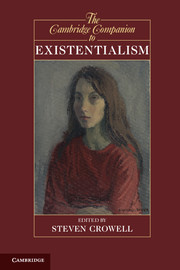Book contents
- Frontmatter
- I Introduction
- II Existentialism in Historical Perspective
- III Major Existentialist Philosophers
- 4 Kierkegaard’s single individual and the point of indirect communication
- 5 “What a monster then is man”: Pascal and Kierkegaard on being a contradictory self and what to do about it
- 6 Nietzsche: after the death of God
- 7 Nietzsche: selfhood, creativity, and philosophy
- 8 Heidegger: the existential analytic of Dasein
- 9 The antinomy of being: Heidegger’s critique of humanism
- 10 Sartre’s existentialism and the nature of consciousness
- 11 Political existentialism: the career of Sartre’s political thought
- 12 Simone de Beauvoir’s existentialism: freedom and ambiguity in the human world
- 13 Merleau-Ponty on body, flesh, and visibility
- IV The Reach of Existential Philosophy
- Bibliography
- Index
- OTHER VOLUMES IN THE SERIES OF CAMBRIDGE COMPANIONS
8 - Heidegger: the existential analytic of Dasein
from III - Major Existentialist Philosophers
Published online by Cambridge University Press: 28 March 2012
- Frontmatter
- I Introduction
- II Existentialism in Historical Perspective
- III Major Existentialist Philosophers
- 4 Kierkegaard’s single individual and the point of indirect communication
- 5 “What a monster then is man”: Pascal and Kierkegaard on being a contradictory self and what to do about it
- 6 Nietzsche: after the death of God
- 7 Nietzsche: selfhood, creativity, and philosophy
- 8 Heidegger: the existential analytic of Dasein
- 9 The antinomy of being: Heidegger’s critique of humanism
- 10 Sartre’s existentialism and the nature of consciousness
- 11 Political existentialism: the career of Sartre’s political thought
- 12 Simone de Beauvoir’s existentialism: freedom and ambiguity in the human world
- 13 Merleau-Ponty on body, flesh, and visibility
- IV The Reach of Existential Philosophy
- Bibliography
- Index
- OTHER VOLUMES IN THE SERIES OF CAMBRIDGE COMPANIONS
Summary
HEIDEGGER'S ONTOLOGY IN BEING AND TIME
On page 67 of Being and Time Heidegger writes, “The ‘essence’ of Dasein lies in its existence.” This formula was the inspiration for Jean-Paul Sartre's better known thesis that “existence precedes essence.” What can it mean to say that our “essence” lies in our existence, and why does Heidegger put “essence” in quotation marks? We may assume that by the latter device Heidegger means to indicate that the sense in which Dasein has an essence is rather different from the sense in which non-human things have essences, or perhaps even that Dasein does not really have an essence at all. In the preceding paragraph he writes,
The “essence” of this entity lies in its to-be [Zu-sein]. Its being-what-it-is (essentia) must, so far as we can speak of it at all, be conceived in terms of its being (existentia). (BT, p. 67; H, p. 42)
The phrase “to-be” is more gerundive than gerund; it expresses the idea that we have our being to be, as we may have tasks to do or miles to walk. Our essence, our “what-we-are” (or better, “who-we-are”), is determined by how we live, and how we live is structured by how we are called upon to live. Called upon by whom or what? By ourselves. (We shall explore this thought later.) In the paragraph in which Heidegger makes this statement he infers from it that Dasein is not an entity “present-at-hand.
- Type
- Chapter
- Information
- The Cambridge Companion to Existentialism , pp. 158 - 177Publisher: Cambridge University PressPrint publication year: 2012
- 2
- Cited by

